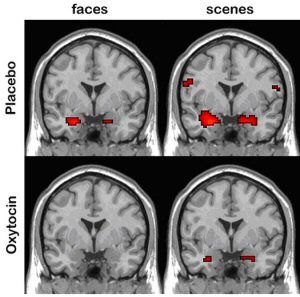A brain imaging study at the National Institute of Mental Health (NIMH) revealed that the brain chemical oxytocin, also known as the "trust" hormone, causes a short circuit in electrical circuits in the human brain associated with processing the emotion of fear

A brain imaging study at the National Institute of Mental Health (NIMH) revealed that the brain chemical oxytocin, also known as the "trust" hormone, causes a short circuit in electrical circuits in the human brain associated with processing the emotion of fear.
Scans on the effect of oxytocin on the human brain reveal that the hormone suppresses the abode of the emotion of fear in the amygdala and the establishment station linked to it in the brainstem, as a response to the formation of a feeling of fear. The work may yield new approaches to the treatment of diseases caused by amygdala dysfunction as well as social fear such as social phobia, autism, and possibly even schizophrenia, the study suggests.
A report by Swiss scientists last summer on the link between oxytocin and increased trust in humans is what inspired the new study. Wanting to understand the profound effects, researcher Andreas Meyer-Lindenberg and his colleagues started a brain imaging study that tests how oxytocin affects the electrical circuits in the brain. Now observing a decrease in amygdala activity as a response to a social encounter in people with a rare genetic brain disease, which leads them to trust others excessively, Meyer-Lindenberg hypothesizes that oxytocin accelerates the process of acquiring trust by suppressing the amygdala and the processing circuits of the feeling of fear.
The experiment he designed to test his theory involved 15 healthy men who inhaled oxytocin or a placebo, having previously undergone a functional magnetic resonance imaging (fMRI) scan. While they were being scanned, the men were asked to perform tasks known to stimulate the amygdala - viewing images showing angry or fearful faces and threatening scenes.
Meier-Lindenberg found that the threatening presentations evoked a strong response in the amygdala area in the placebo scans, compared to the scans of the oxytocin subjects, who had markedly lower activity. In particular, the difference in responses to images of threatening faces is reflected, which suggests a major role of oxytocin in regulating social fear. In addition, the oxytocin obscured the communication between the amygdala and the upper part of the brainstem, which is responsible for transmitting the fear response.
The researchers believe that their findings, which appear in the journal "Neuroscience", will be applied in the treatment of various mental illnesses. "Because increased amygdala activity is associated with social fear, social phobias, genetic risk for anxiety, depression, and may be related to social fear in the process of evaluating facial expressions in autistics, the dual nature of oxytocin in its effect on humans offers a potentially powerful tool for treating relevant social fears," says Meyer -Lindenberg.

One response
If there is an experiment and research on the topic of the trust hormone I would be happy to participate, I have already tried different methods for treating social anxiety without success